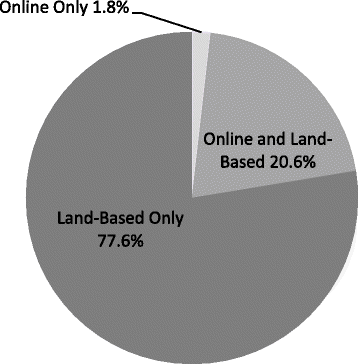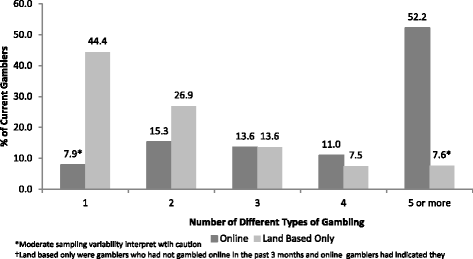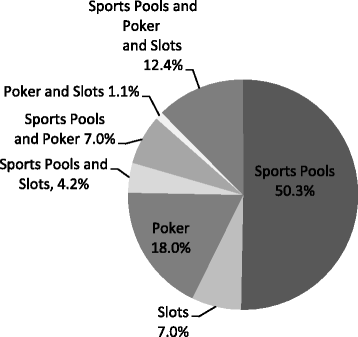An examination of internet and land-based gambling among adolescents in three Canadian provinces: results from the youth gambling survey (YGS) - PubMed (original) (raw)
An examination of internet and land-based gambling among adolescents in three Canadian provinces: results from the youth gambling survey (YGS)
Tara Elton-Marshall et al. BMC Public Health. 2016.
Abstract
Background: With the rapid proliferation of new gambling technology and online gambling opportunities, there is a concern that online gambling could have a significant impact on public health, particularly for adolescents. The aim of this study is to examine online and land-based gambling behaviour among adolescents in 3 Canadian provinces (Ontario, Newfoundland and Labrador, Saskatchewan) prior to the implementation of legalized online gambling.
Methods: Data are from 10,035 students in grades 9 to 12 who responded to the 2012-2013 Youth Gambling Survey (YGS) supplement, a questionnaire administered as part of the Canadian Youth Smoking Survey (YSS, 2012) in 3 provinces: Newfoundland and Labrador (n = 2,588), Ontario (n = 3,892), and Saskatchewan (n = 3,555).
Results: Overall, 41.6% of adolescents (35.9% of females and 47.4% of males) had gambled in the past 3 months. 9.4% of adolescents had gambled online in the past 3 months alone (3.7% of females and 15.3% of males). The most popular form of online gambling was online sports betting. Adolescents also engaged in online simulated gambling including internet poker (9.1%) and simulated gambling on Facebook (9.0%). Few adolescents participated in online gambling exclusively and online gamblers were more likely than land-based gamblers to engage in multiple forms of gambling. A higher proportion of adolescent online gamblers scored "high" or "low to moderate" in problem gambling severity compared to land-based only gamblers.
Conclusions: Despite restrictions on online gambling at the time of the study, adolescents were engaging in online gambling at a significantly higher rate than has been previously found. Adolescents were also using technology such as video games to gamble and free online gambling simulations.
Keywords: Adolescent; Gambling; Online; Prevalence.
Figures
Fig. 1
Online and Land-Based Gambling Prevalence, Youth Gambling Survey Saskatchewan, Ontario, and Newfoundland and Labrador (Canada) 2012-2013
Fig. 2
Number of Types of Gambling by Online (_n_=833) vs. Land Based Gamblers(_n_=3041)† Youth Gambling Survey Saskatchewan, Ontario, and Newfoundland and Labrador (Canada) 2012-2013
Fig. 3
Online Gambling Participation by Type (n=833), Youth Gambling Survey Saskatchewan, Ontario, and Newfoundland and Labrador (Canada) 2012-2013
Similar articles
- Factors associated with social casino gaming among adolescents across game types.
Veselka L, Wijesingha R, Leatherdale ST, Turner NE, Elton-Marshall T. Veselka L, et al. BMC Public Health. 2018 Oct 11;18(1):1167. doi: 10.1186/s12889-018-6069-2. BMC Public Health. 2018. PMID: 30305091 Free PMC article. - Mental Health and Online, Land-Based and Mixed Gamblers.
Blaszczynski A, Russell A, Gainsbury S, Hing N. Blaszczynski A, et al. J Gambl Stud. 2016 Mar;32(1):261-75. doi: 10.1007/s10899-015-9528-z. J Gambl Stud. 2016. PMID: 25744658 - [Internet gambling: what are the risks?].
Bonnaire C. Bonnaire C. Encephale. 2012 Feb;38(1):42-9. doi: 10.1016/j.encep.2011.01.014. Epub 2011 Apr 8. Encephale. 2012. PMID: 22381723 Review. French. - Isolating the impact of specific gambling activities and modes on problem gambling and psychological distress in internet gamblers.
Gainsbury SM, Angus DJ, Blaszczynski A. Gainsbury SM, et al. BMC Public Health. 2019 Oct 25;19(1):1372. doi: 10.1186/s12889-019-7738-5. BMC Public Health. 2019. PMID: 31653242 Free PMC article. - Internet-based interventions for youth dealing with gambling problems.
Monaghan S, Wood RT. Monaghan S, et al. Int J Adolesc Med Health. 2010 Jan-Mar;22(1):113-28. Int J Adolesc Med Health. 2010. PMID: 20491421 Review.
Cited by
- Traumatic brain injuries and problem gambling in youth: Evidence from a population-based study of secondary students in Ontario, Canada.
Turner NE, Cook S, Shi J, Elton-Marshall T, Hamilton H, Ilie G, Wickens CM, McDonald AJ, Trajtenberg N, Cusimano MD, Mann RE. Turner NE, et al. PLoS One. 2020 Oct 2;15(10):e0239661. doi: 10.1371/journal.pone.0239661. eCollection 2020. PLoS One. 2020. PMID: 33007032 Free PMC article. - Examining neural reactivity to gambling cues in the age of online betting.
Brevers D, Sescousse G, Maurage P, Billieux J. Brevers D, et al. Curr Behav Neurosci Rep. 2019 Sep;6(3):59-71. doi: 10.1007/s40473-019-00177-2. Epub 2019 May 23. Curr Behav Neurosci Rep. 2019. PMID: 31396472 Free PMC article. - Problem gambling in adolescents: what are the psychological, social and financial consequences?
Livazović G, Bojčić K. Livazović G, et al. BMC Psychiatry. 2019 Oct 22;19(1):308. doi: 10.1186/s12888-019-2293-2. BMC Psychiatry. 2019. PMID: 31640621 Free PMC article. - Do Simulated Gambling Activities Predict Gambling with Real Money During Adolescence? Empirical Findings from a Longitudinal Study.
Hayer T, Kalke J, Meyer G, Brosowski T. Hayer T, et al. J Gambl Stud. 2018 Sep;34(3):929-947. doi: 10.1007/s10899-018-9755-1. J Gambl Stud. 2018. PMID: 29435822 - The impact of COVID-19 lockdown on gambling habit: A cross-sectional study from Italy.
Lugo A, Stival C, Paroni L, Amerio A, Carreras G, Gorini G, Mastrobattista L, Minutillo A, Mortali C, Odone A, Pacifici R, Tinghino B, Gallus S. Lugo A, et al. J Behav Addict. 2021 Jul 20;10(3):711-721. doi: 10.1556/2006.2021.00033. J Behav Addict. 2021. PMID: 34283804 Free PMC article.
References
- Derevensky JL. Teen gambling: Understanding a growing epidemic. Lanham, Md: Rowman & Littlefield Publishers; 2012.
- Office of the Auditor General of Ontario . Ontario Lottery and Gaming Corporation’s modernization plan. Toronto: Queen’s Printer for Ontario; 2014.
Publication types
MeSH terms
LinkOut - more resources
Full Text Sources
Other Literature Sources
Medical
Miscellaneous


